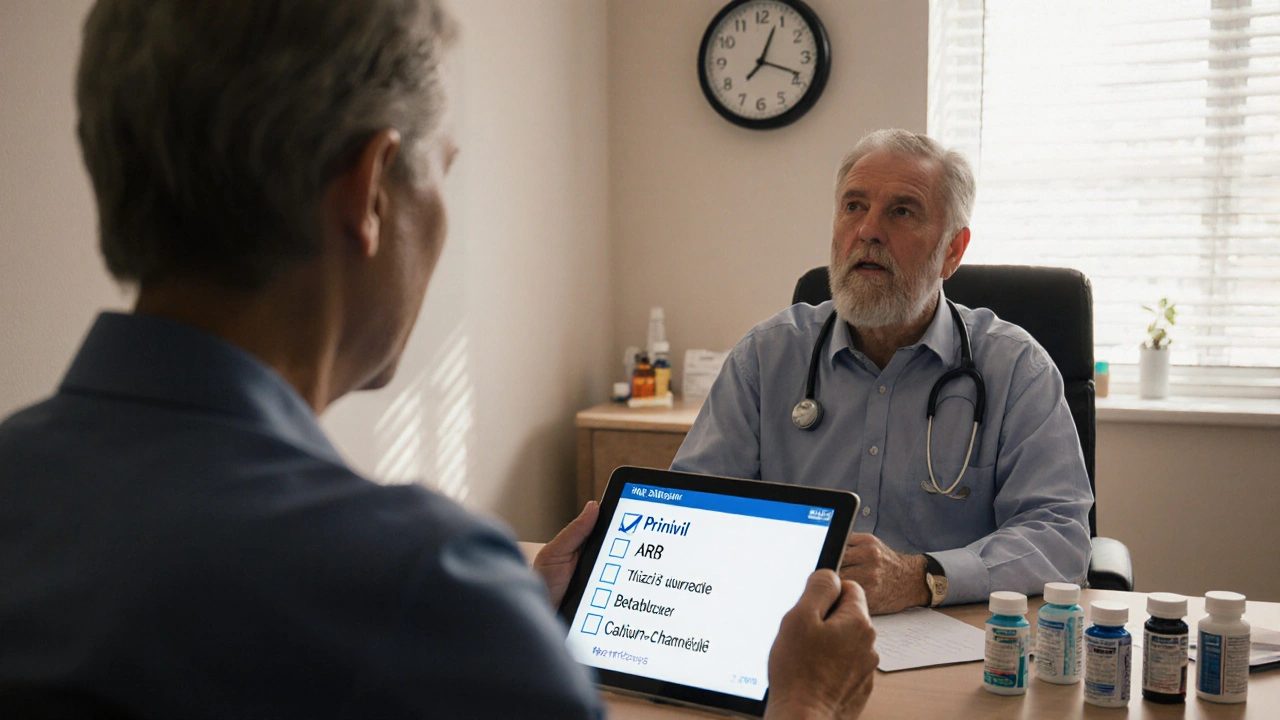
Blood Pressure Medication Comparison Tool
Prinivil (Lisinopril) - ACE Inhibitor
Blocks angiotensin I conversion to angiotensin II, relaxing blood vessels and reducing heart workload. Effective for hypertension and heart protection.
ARBs - Angiotensin II Receptor Blockers
Blocks angiotensin II receptors directly, achieving similar BP reduction with fewer cough side effects.
Thiazide Diuretics
Increases urine output to reduce blood volume and pressure. Often combined with other medications.
Beta-Blockers
Slows heart rate and decreases cardiac output. Especially helpful post-heart attack or for arrhythmias.
Calcium-Channel Blockers
Relaxes arterial smooth muscle for vasodilation. Effective for isolated systolic hypertension in elderly.
Key Comparison Points:
- Cost: Generic versions of Prinivil are typically very affordable compared to brand-name drugs
- Side Effects: ACE inhibitors commonly cause dry cough; ARBs rarely do
- Effectiveness: All classes effectively lower blood pressure, but individual responses vary
- Combination Therapy: Often used together for better control
Important: Always consult with your healthcare provider before changing medications or dosages.
When your doctor writes Prinivil is a brand name for lisinopril, an ACE inhibitor used to lower blood pressure and protect the heart, you might wonder if there’s a cheaper pill or one with fewer side effects. This guide breaks down how Prinivil stacks up against the most common alternatives - ARBs, thiazide diuretics, beta‑blockers, and calcium‑channel blockers - so you can decide what fits your health goals and wallet.
What Prinivil (Lisinopril) Actually Does
Prinivil belongs to the class of ACE inhibitors (drugs that block the conversion of angiotensin I to angiotensin II, a potent vessel‑constricting hormone). By lowering angiotensin II levels, the medication relaxes blood vessels, reduces the workload on the heart, and can slow the progression of kidney disease in people with diabetes.
Typical starting dose for hypertension is 10mg once daily, with a usual maintenance range of 20‑40mg. The drug is taken orally, and food doesn’t affect absorption.
How the Main Alternatives Work
Not everyone tolerates ACE inhibitors well. Below are the four most prescribed alternatives and how they differ.
AngiotensinIIReceptor Blockers (ARBs)
ARBs, such as losartan and valsartan, block angiotensin II receptors directly (preventing the hormone from tightening blood vessels). They achieve the same blood‑pressure‑lowering effect as ACE inhibitors but usually cause fewer cough‑related side effects.
Hydrochlorothiazide (Thiazide Diuretic)
Hydrochlorothiazide, often shortened to HCTZ, increases urine output (helping the kidneys flush out excess sodium and water). The reduced blood volume leads to lower pressure. It’s frequently combined with an ACE inhibitor or ARB for additive effect.
Beta‑Blockers
Common beta‑blockers like atenolol and metoprolol slow the heart rate and decrease cardiac output (which drops systolic pressure). They’re especially useful after a heart attack or for patients with arrhythmias.
Calcium‑Channel Blockers (CCBs)
Drugs such as amlodipine and diltiazem relax the smooth muscle in arterial walls (leading to vasodilation). CCBs work well for isolated systolic hypertension, a common issue in older adults.

Side‑Effect Profile - What to Expect
Every class has its own trade‑offs. Here’s a quick look at the most reported adverse events:
- ACE inhibitors (Prinivil): dry cough, elevated potassium, rare angio‑edema.
- ARBs: similar to ACE inhibitors but cough occurs in <1% of users; may cause dizziness.
- Thiazide diuretics: increased urination, low potassium, mild rise in blood sugar.
- Beta‑blockers: fatigue, cold extremities, possible worsening of asthma.
- CCBs: swelling of ankles, headache, gum overgrowth (rare).
Choosing the right drug often means balancing these side‑effects against your personal health picture - for example, a patient with gout may avoid thiazides because they can raise uric acid.
Cost and Accessibility in Australia
Prinivil is listed on the Pharmaceutical Benefits Scheme (PBS) under the generic name lisinopril. As of October2025, the PBS price is roughly AU$5 for a 30‑day supply. Most ARBs are also PBS‑listed but can be slightly pricier (AU$6‑8). Thiazides, beta‑blockers, and CCBs are generally inexpensive, often under AU$4 per month.
Insurance coverage, brand‑name versus generic, and pharmacy discounts can shift the numbers, so it’s worth checking the MyHealth portal for the latest rebates.
Choosing the Right Option - Decision Checklist
- Do you have a chronic cough or a history of angio‑edema? → Consider an ARB.
- Is potassium level a concern (e.g., kidney disease, supplements)? → Thiazide or CCB may be safer.
- Have you had a recent heart attack? → Beta‑blocker adds cardiac protection.
- Are you over 65 with isolated systolic hypertension? → CCBs often work best.
- Is cost the primary driver? → Compare PBS prices and generic availability.
Discuss the checklist with your GP; they can tailor the regimen based on lab results and comorbidities.

Quick Comparison Table
| Drug Class | Typical Mechanism | Common Dose Range | Most Notable Side‑Effect | PBS Cost (AU$ per month) | Kidney Protection? |
|---|---|---|---|---|---|
| ACE inhibitor (Prinivil) | Blocks angiotensin‑I → II conversion | 10‑40mg daily | Dry cough | ~5 | Yes, especially in diabetic nephropathy |
| ARB | Blocks angiotensin‑II receptors | 50‑100mg daily | Rare dizziness | 6‑8 | Similar to ACE inhibitors |
| Thiazide diuretic | Increases renal sodium & water excretion | 12.5‑25mg daily | Low potassium | ~3 | Neutral; may worsen kidney function if volume‑depleted |
| Beta‑blocker | Reduces heart rate & cardiac output | 25‑100mg daily | Fatigue | ~4 | Indirect benefit post‑MI |
| Calcium‑channel blocker | Vasodilation via calcium entry blockade | 5‑10mg daily | Ankle swelling | ~4 | Neutral |
Frequently Asked Questions
Frequently Asked Questions
Can I switch from Prinivil to an ARB without a wash‑out period?
Yes, most clinicians advise a direct switch because both classes act on the renin‑angiotensin system. However, monitor potassium and kidney function for a week after the change.
Why does Prinivil cause a cough?
ACE inhibitors increase bradykinin levels in the lungs, which can trigger a dry, persistent cough in up to 10% of users.
Is Prinivil safe during pregnancy?
No. ACE inhibitors are contraindicated in the second and third trimesters because they can harm fetal kidney development.
How often should I have blood tests while on Prinivil?
Check kidney function and electrolytes (creatinine, potassium) at baseline, then 1‑2weeks after starting, and again at 3‑months. Annual monitoring is typical if stable.
Can I take Prinivil with a thiazide diuretic?
Yes, the combination is common and often more effective than either alone. Just keep an eye on potassium levels.
Richa Punyani
Choosing the right antihypertensive can feel overwhelming, but keeping your health goals front‑and‑center makes the decision easier; Prinivil offers a solid balance of efficacy and cost, while alternatives like ARBs or thiazides can fill specific gaps such as cough sensitivity or fluid retention concerns. It’s wise to discuss these nuances with your clinician so you can tailor therapy to both your medical profile and lifestyle preferences.
Stay motivated, stay informed!
Bhupendra Darji
In my experience, pairing an ACE inhibitor with a low‑dose thiazide often smooths out blood pressure spikes without piling on side effects, and if you’re prone to a dry cough, swapping to an ARB is a practical workaround. Both classes lower risk for heart events, so the choice really hinges on personal tolerance and any kidney considerations.
Robert Keter
When you first read about lisinopril, the hum of clinical jargon can feel like a distant thunderstorm, yet beneath that rumble lies a remarkable mechanism that gently coerces the renin‑angiotensin system into a state of calm surrender; by halting the conversion of angiotensin I to the vasoconstrictor angiotensin II, the drug not only dilates vessels but also lightens the heart’s perpetual burden of pumping against stubborn pressure. This biochemical ballet, though elegant, is not without its shadows, for a dry cough can surface as an uninvited chorus, reminding patients of the delicate balance between benefit and irritation. In contrast, ARBs such as losartan stride onto the stage with comparable potency while largely sparing the airway, a feature that many patients herald as a triumph of tolerability. Yet the price tag of these newer agents can climb higher than the modest generics of Prinivil, prompting a financial tug‑of‑war that’s hard to ignore in everyday life. Thiazide diuretics, by urging the kidneys to excrete excess sodium and water, play a different but equally vital tune, often amplifying the effect of a ACE inhibitor when combined, though they may summon frequent bathroom trips that some find inconvenient. Beta‑blockers, the stalwart defenders post‑myocardial infarction, temper heart rate and contractility, offering a shield against arrhythmias, yet they can cast a veil of fatigue over the days, especially in the active individual. Calcium‑channel blockers, on the other hand, swoop in with arterial vasodilation, excelling in isolated systolic hypertension common among seniors, but they sometimes bring swelling of the ankles that can be mistaken for fluid overload. Each class, therefore, presents a unique mosaic of advantages and trade‑offs, and the clinician’s art lies in weaving these pieces into a personalized tapestry. Monitoring electrolytes becomes essential when potassium‑sparing ACE inhibitors meet certain dietary patterns, while vigilant observation for rare angioedema remains a safety net that never truly rests. The overarching narrative, however, is one of collaboration: patients, physicians, and sometimes pharmacists must converse openly about symptoms, costs, and preferences, ensuring that the chosen regimen does not merely lower numbers on a chart but also enhances quality of life. In practice, many find that a modest dose of lisinopril, titrated slowly, delivers stable control with minimal cough, especially when paired with a low‑dose thiazide to blunt any lingering spikes. If the cough becomes relentless, a swift transition to an ARB can restore comfort without sacrificing cardiovascular protection. Ultimately, the decision is a dynamic journey, not a static prescription, guided by evolving evidence, individual response, and the ever‑present goal of keeping the heart healthy and the patient happy.
Rory Martin
One must also consider that the pharmaceutical giants behind ACE inhibitors have long histories of influencing research outcomes, and the subtle push toward brand‑name prescriptions can obscure truly independent data, making it prudent to scrutinize the source of any recommendation you receive.
Maddie Wagner
While the detailed mechanisms are fascinating, from a practical standpoint it’s helpful to remember that most insurers cover generic lisinopril at a fraction of the cost of ARBs, and that a simple blood test can catch rising potassium before it becomes dangerous; staying proactive with labs and lifestyle tweaks like reduced sodium intake can maximize the benefits of any chosen agent.
Boston Farm to School
Across many cultures, hypertension is often called the “silent killer,” and community health programs that teach low‑salt cooking and regular walking have shown measurable drops in blood pressure, complementing the pharmacologic effects of drugs like lisinopril and thiazides.
Emily Collier
It’s encouraging to see that, when patients adhere to a well‑chosen regimen, the risk of heart failure diminishes markedly; remember that consistency and open dialogue with your provider are key ingredients in turning medication data into lasting wellness.
Catherine Zeigler
Keep in mind that small victories, like remembering to take your dose at the same time each day, build momentum; pairing the medication with a morning routine-maybe a glass of water and a brief stretch-can turn compliance into a habit rather than a chore.
henry leathem
ACE inhibitors are overrated and induce unnecessary cough.
jeff lamore
While it’s true that ACE inhibitors have a solid evidence base, the decision should also weigh patient‑specific factors such as kidney function, potential drug interactions, and personal tolerance, ensuring that the therapeutic plan remains individualized and safe.
Kris cree9
Honestly, most people just grab the cheapest pill and call it a day; the rest is just hype.
Paula Hines
When we talk about blood pressure drugs, it’s worth noting that American pharmaceutical standards often set the bar higher than many other countries, which can mean both better quality control and, paradoxically, higher prices that push some patients toward cheaper but sometimes less rigorously tested alternatives.
John Babko
Our nation’s commitment to medical innovation has produced lifesaving classes like ACE inhibitors and ARBs, and it’s a point of pride that we continue to lead in cardiovascular research, even if the market dynamics occasionally feel frustrating.
Let’s acknowledge the progress while striving for affordable access.
Stacy McAlpine
For anyone looking to start a medication, ask your doctor about the simplest regimen possible-often a single daily pill like lisinopril-so you can stick to it without confusion, and keep an eye on any side effects that might pop up early.





Write a comment